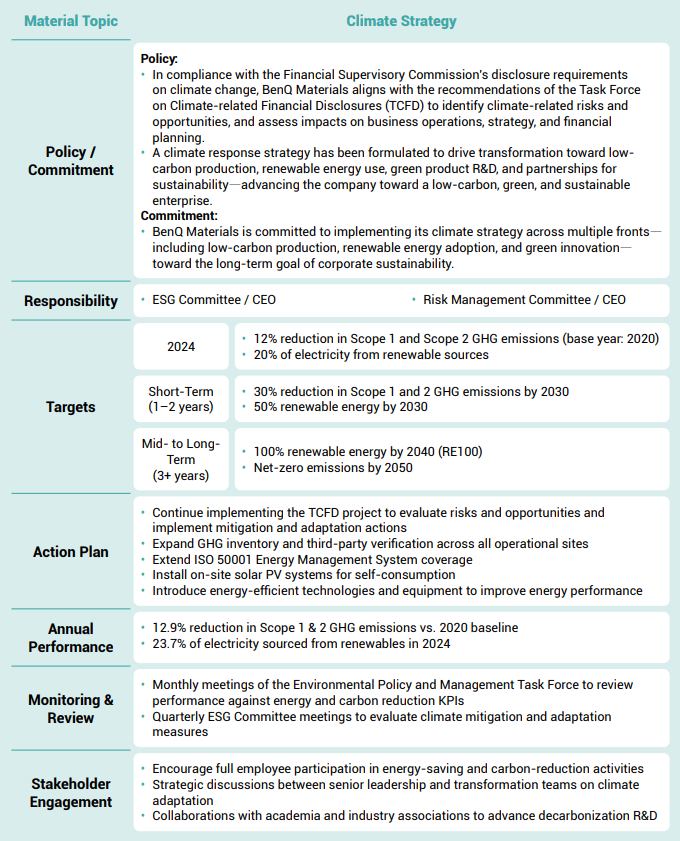Climate Change Management
In 2021, BenQ Materials officially set its 2050 net-zero emissions target through the ESG Sustainability Committee. In alignment with the results of its greenhouse gas (GHG) inventory and the company's development trends, BenQ Materials has formulated short-, medium-, and long-term carbon reduction goals and strategies. To address climate change mitigation and adaptation, the company continues to implement the ISO 14001 Environmental Management System and ISO 50001 Energy Management System while carrying out various energy-saving, carbon-reduction, and resource efficiency improvement initiatives.
In recent years, the company has proactively invested in the application of artificial intelligence (AI) technology and new equipment to enhance production efficiency and achieve low-carbon transformation. Additionally, BenQ Materials has installed on-site solar power systems at its facilities to expand the use of renewable energy and is dedicated to developing low-carbon, green products. The company collaborates closely with sustainable supply chain partners, comprehensively advancing toward low-carbon, green, and sustainable corporate development.
BenQ Materials supports the Paris Agreement and commits to limiting global warming to well below 2˚C and strives to pursue efforts to limit the temperature increase to 1.5˚C. Although the company has not yet obtained certification for the 1.5˚C target under the Science Based Targets initiative (SBTi), it has completed its carbon inventory and formulated carbon reduction pathways and targets. In the future, BenQ Materials will carefully assess the feasibility of applying for SBTi certification based on actual operating conditions and industry development trends.
Every year, BenQ Materials engages in regular dialogues with the Taiwan Panel & Optoelectronic Materials and Device Association (TPSA) and the Taiwan Climate Partnership (TCP), discussing sustainability topics related to climate change, including the application of carbon reduction technologies, renewable energy procurement strategies, and industry sustainability trends, as well as sharing practical experiences and challenges. Through ongoing collaboration and dialogue, the company ensures that its actions and those of its industry partners are aligned with the Paris Agreement goal of limiting global warming to 1.5˚C.
Moreover, the company regularly reviews the climate positions of its industry sectors and the trade associations it participates in to ensure alignment with its own climate commitments and the targets of the Paris Agreement. If any inconsistencies are identified, appropriate actions will be taken, including expressing its stance to the associations or reevaluating its membership.
Net-Zero Roadmap
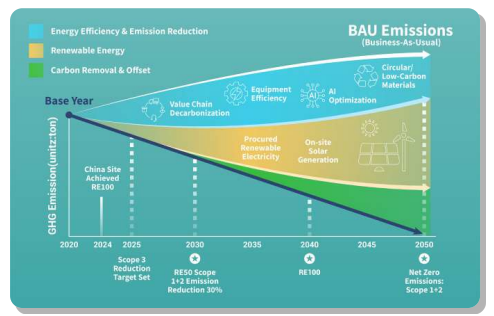
Climate Change Management Working Team
BenQ Materials has established the "Climate Change Management Task Force," with the CEO and General Manager serving as Chairman and Vice Chairman, respectively. The firstlevel supervisors from each unit serve as committee members, and the CFO/Risk Management Unit serves as the Secretary General. This task force is responsible for promoting activities related to climate change management.

TCFD Operation and Management Framework
| Aspect |
BenQ Materials Strategy and Action Plan |
Governance
|
- The Board of Directors regularly reviews climate change-related risks and opportunities:
• Since 2022, BenQ Materials has reported annually to the Board of Directors and Audit Committee on the management of climate-related issues. The most recent report was completed on October 31, 2024.
• The Climate Change Management Task Force organizational structure is shown above. Each year, the company identifies and assesses climate-related risks and opportunities. Based on a comprehensive evaluation of potential financial and other impacts, the task force formulates climate adaptation plans, which are reviewed in management review meetings chaired by the Chairperson/Vice Chairperson, ensuring alignment with corporate strategy and timely resource allocation. |
Strategy
|
According to the climate-related risk and opportunity assessment methodology, internal definitions are as follows:
• Time horizon for potential impacts:
– Short-term: 0–3 years
– Mid-term: 3–5 years
– Long-term: 5–10 years
• Impact severity is assessed based on:
– Effects on assets and financials
– Impacts on products and services
– Impacts on personnel
– Reputational impacts 2 Through the identification and assessment process, five key risks and opportunities have been prioritized:
• Risks:
– Extreme weather events (short-term)
– Raw material shortages or increased costs (short-term)
– Rising average temperatures (mid-term)
– Changes in precipitation patterns (mid-term)
– Stricter carbon disclosure requirements / carbon pricing mechanisms (short-term)
• Opportunities:
– Research and innovation in new products and services (short-term)
– Renewable energy and energy-saving opportunities (short-term)
– Development and/or expansion of low-carbon products and services (short-term)
– Reduction of water usage and consumption (long-term) – Recycling and reuse initiatives (short-term)
Scenario Development Approach Includes:
• Transition Scenario: Based on changes in regulations, policies, product demand, and green inflation-related transition assumptions.
• Physical Scenario: Refers to SSP5-8.5 (very high emissions scenario) from the IPCC Sixth Assessment Report (AR6); due to limited external literature, China-based facilities refer to RCP8.5 from the IPCC Fifth Assessment Report (AR5).
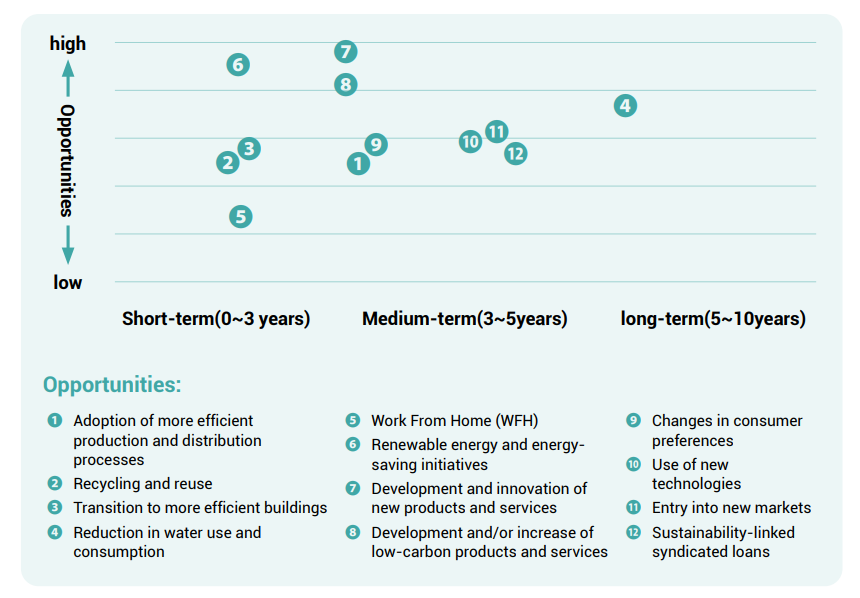  |
Risk Management
|
1 Establishing a Climate Risk Identification Process Using the TCFD Framework:
• Risks are identified and assessed following the TCFD framework, covering both transition risks (such as current and emerging regulations, legal, policy, technology, market, and reputational risks) and physical risks (both acute and chronic).
• Identified risks are prioritized and analyzed based on the assessment results, and findings are reported to the Climate Change Management Task Force during its annual management review meetings to ensure effective implementation.
2 Integration of Climate-Related Issues into Enterprise Risk Management Processes:
• High-risk climate issues are incorporated into executive-level management discussions.
• Transition and physical risks are reviewed annually, and the corresponding adaptation action plans are adjusted dynamically. (Refer to Section 3-5 Risk Management in this report.) |
Metrics and Targets
|
1 Climate Performance Management Indicators and Targets:
• Greenhouse Gas Emissions: 30% reduction by 2030 compared to the baseline year 2020.
• Renewable Energy Usage: 50% by 2030 and 100% by 2040.
• Carbon Reduction for Existing Products: 55% reduction by 2030 compared to the baseline year.
• Ultimate Goal: Achieve net-zero emissions by 2050.
2 Annual GHG Inventory and Strategy Review under ISO 14064-1:2018:
• Conduct greenhouse gas inventory in accordance with ISO 14064-1:2018 and obtain thirdparty assurance statements.
• Target a 30% reduction in emissions by 2030 compared to the 2020 baseline.
• Strive for net-zero emissions by 2050 and achieve key climate-related goals in product design. • For detailed climate adaptation actions, please refer to the table below. |
Climate Change Adaptation Action Plan
Currency: NTD
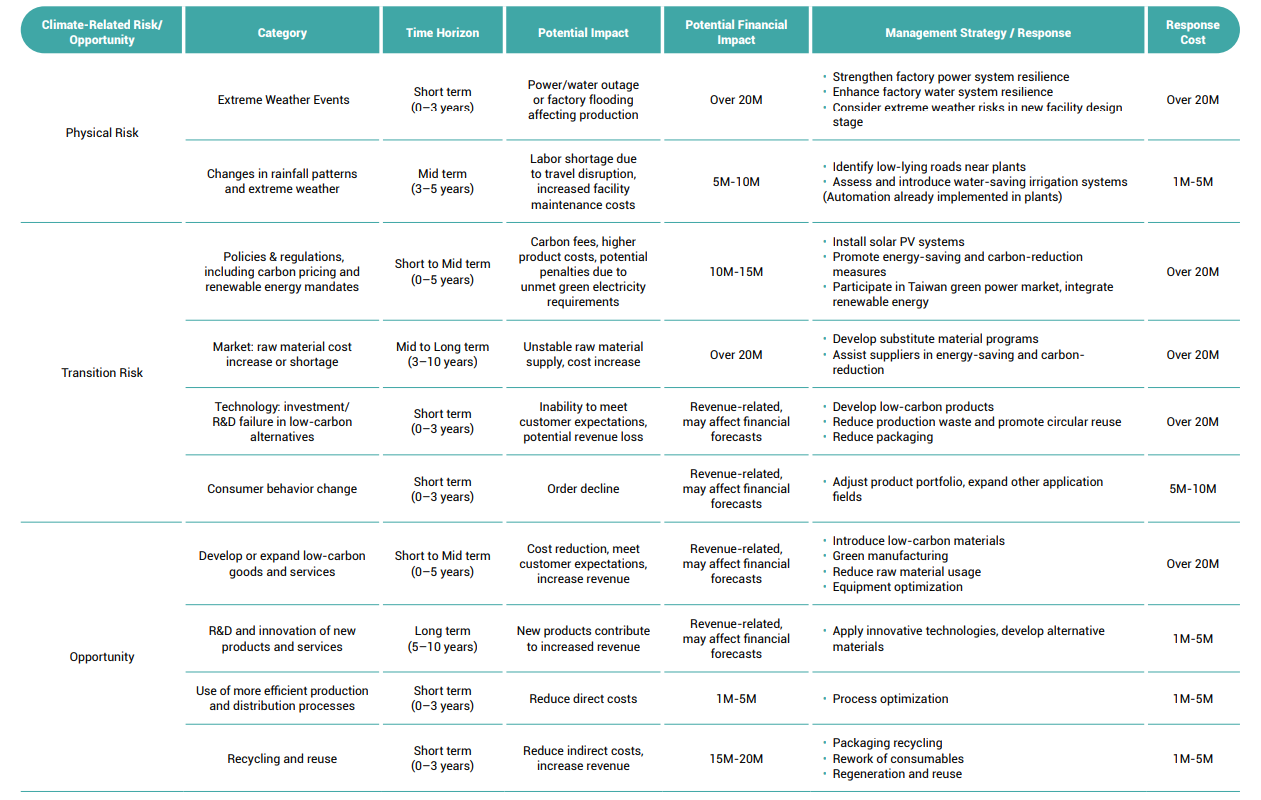
GHG inventory
In 2024, combined Scope 1 and Scope 2 emissions totaled 50,109.36 metric tons of CO2e, representing a 20.04% increase from 2023, mainly due to emissions from newly established production lines. However, this also reflects a 12.91% reduction compared to the 2020 baseline. GHG emissions intensity (Scope 1 + 2) has steadily decreased since 2017. In 2024, emissions intensity reached 2.70 metric tons CO2e per NT$ million revenue, reflecting a 10.60% increase from 2023 but a 29.49% reduction compared to 2020, driven by the adoption of renewable energy and carbon reduction investment projects. Scope 3 emissions in 2024 totaled 77,764.14 metric tons of CO2e, marking a 150.12% increase from 2023 and a 716.26% increase from 2020. The rise is primarily due to the expanded Scope 3 boundaries based on facility-specific characteristics and improved accessibility of emission factors, particularly in categories such as purchased goods and services and upstream transportation and distribution.
GHG Emissions - by scope and Intensity Over the Years
GHG Emissions (by scope) (unit: tCO2e)

GHG Emissions (by emission by) (unit: t)
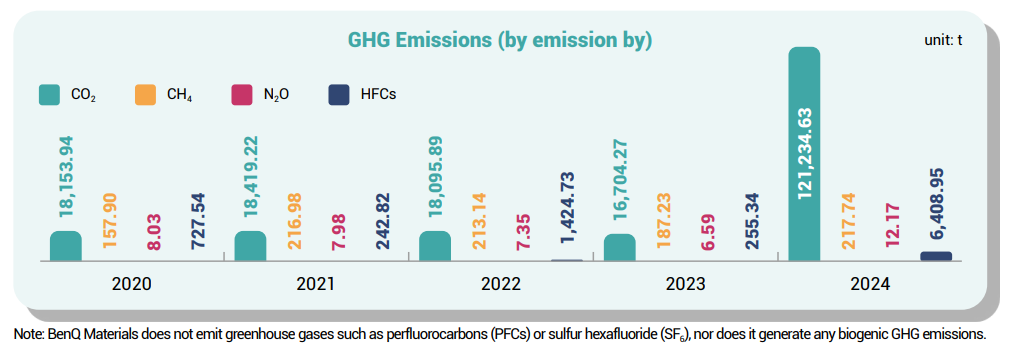
- Note 1: The operational sites verified by a third-party include: BenQ Materials Headquarters, Taoyuan Plant, Lungke Plant, Yunkang Plant, Suzhou Plant, Wuhu Plant, Lienhwa Medical, Hailu Plant, BMC (No. 28), BMM, and DTB. Scope 3 emissions have been accounted for at headquarters and Taiwan sites since 2019, and for overseas sites starting in 2022. Subsidiaries including Web-Pro, Cenefom, and GENE JET Biotech have only completed internal inventories; data from these sites are not yet disclosed in the current scope but are expected to be included after third-party verification in 2025.
- Note 2: The GHG inventory is conducted based on ISO 14064-1:2018. As of 2023, all sites have completed third-party verification.
- Note 3: The electricity emission factor for Taiwan sites is based on the 2023 emission factor published in 2024 by the Bureau of Energy: 0.494 tCO2e/MWh.
- Note 4: The electricity emission factor for China sites is based on the 2022 national average carbon emission factor published by the Ministry of Ecology and Environment of China: 0.5366 tCO2e/MWh.
- Note 5: The organizational boundary for BenQ Materials Headquarters, Taoyuan Plant, Lungke Plant, Yunkang Plant, Suzhou Plant, Wuhu Plant, Lienhwa Medical, Hailu Plant, BMC (No. 28), BMM, and DTB is set using the Operational Control approach.
- Note 6: GWP values used for emissions calculations: For BenQ Materials Headquarters, Taoyuan Plant, Lungke Plant, Yunkang Plant, Lienhwa Medical, Hailu Plant, and BMC (No. 28): IPCC Fifth Assessment Report (AR5). For Suzhou Plant, Wuhu Plant, BMM, and DTB: IPCC Sixth Assessment Report (AR6).
Sustainability Topic Management Approach
